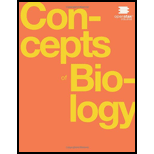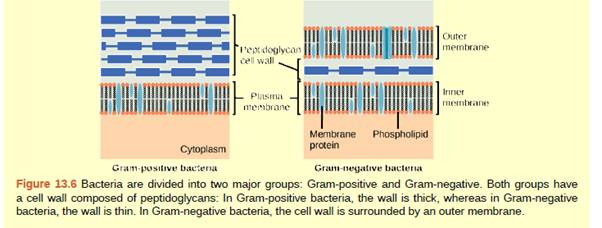
Concept explainers
Figure 13.6 Which of the following statements is true?
a. Gram-positive bacteria have a single cell wall formed from peptidoglycan.
b. Gram-positive bacteria have an outer membrane.
c. The cell wall of Gram-negative bacteria is thick, and the cell wall of Gram-positive bacteria is thin.
d. Gram-negative bacteria have a cell wall made of peptidoglycan, while Gram-positive bacteria have a cell wall made of phospholipids.

Introduction:
The gram stain test is used to differentiate between the gram-positive bacteria and gram-negative bacteria. The gram-positive bacteria retain the crystal violet stain of the gram stain test. While, the gram-negative bacteria, do not retain the crystal violet stain when discoloring agent is applied to it.
Answer to Problem 1ACQ
Correct answer:
Among the answers given, the correct answer is option (a) the cell wall of gram-positive bacteria us formed only of peptidoglycan.
Explanation of Solution
Explanation/justification for the correct answer:
Option (a) is the cell wall of gram-positive bacteria is formed only of peptidoglycan. The cell wall of gram-positive bacteria is thick as it contains many layers of peptidoglycan. Whereas, the cell wall of gram-negative bacteria is thin layered and is composed of peptidoglycan and other structures. Hence, this option is correct.
Explanation for incorrect answer:
Option (b) is gram-positive bacteria contains an outer membrane. The cell wall of gram-negative bacteria is surrounded by an outer membrane, while there is no outer membrane in gram-positive bacteria. Hence, this option is incorrect.
Option (c) is the cell wall of gram-negative bacteria is thick and that of gram-positive bacteria is thin. Many layers of peptidoglycan make the cell wall of gram-positive bacteria thick, while a single layer of peptidoglycan in gram-negative bacteria makes the cell wall thin. Hence, this option is incorrect.
Option (d) is the cell wall of gram-negative bacteria is made of peptidoglycan and that of gram-positive bacteria is made of phospholipids. The cell wall of gram-positive bacteria does not contain phospholipids. It is made up only of peptidoglycan. On the other hand, the cell wall of gram-negative bacteria contains other structures along with peptidoglycan. Hence, this option is incorrect.
The correct statement is that gram positive bacteria contains only of peptidoglycan. Hence, option (a) is correct.
Want to see more full solutions like this?
Chapter 13 Solutions
Concepts of Biology
Additional Science Textbook Solutions
College Physics
Human Biology: Concepts and Current Issues (8th Edition)
Biology: Life on Earth
Becker's World of the Cell (9th Edition)
Microbiology with Diseases by Body System (5th Edition)
Study Guide for Campbell Biology
- Which of the following is NOT a true statement about bacterial structure and function? A. Bacteria can have membrane-enclosed organelles such as mitochondria or chloroplasts B. Bacteria have a single circular chromosome made of double-stranded DNA C. Bacterial cell walls are made of a substance called peptidoglycan D. Bacterial flagella rotate to propel the cell E. Some bacteria have a capsule surrounding the cell, made of a sticky polysaccharide or proteinarrow_forwardAll of the following are characteristics of the bacterial flagellum except: Select one: a. It has a hook-like insertion to a basal body in the cell wall. b. It is composed of protein c. It is used in conjugation d. Counterclockwise rotation moves bacteria forward All the following are characteristics of prokaryotes except: Select one: a. Prokaryotes have cell wall b. Prokaryotes have ribosomes c . Prokaryotes have organelles d. Prokaryotes lack a nucleus e. Prokaryotes have genesarrow_forwardWhich of the following is present in both gram-positive and gram-negative cell walls?a. an outer membrane b. peptidoglycanc. teichoic acidd. lipopolysaccharidesarrow_forward
- We will perform a gram stain on our samples, so be sure to bring your instructions on gram staining. Will this procedure stain all cells? A. Yes, all prokaryotic and eukaryotic cells will be stained purple or pink. B. All prokaryotic cells will be stained. Eukaryotic cells will not be stained. C.Mycobacteria and a few other groups with special cell wall structures will not be stained. All other prokaryotic cells will be stained. Eukaryotic cells will be stained pink. D. Mycobacteria and a few other groups with special cell wall structures will not be stained. All other prokaryotic cells will be stained. Eukaryotic cells will be stained purple.arrow_forwardWhich of the following is NOT a characteristic for bacteria in general? a. Plasma membrane has no saccharide units b. Sterols is one of its major outer membrane component c. Genome present in the nucleiod region of the cytosol d. Granules are mostly polysaccharide in naturearrow_forwardGram-positive (+) and gram-negative (-) bacteria are characterized by differences in a. the cell wall: gram+ have peptidoglycan, gram– have pseudopeptidoglycan. b. the plasma membrane: gram+ have ester-linked lipids, gram–have ether-linked lipids. c. the cell wall: gram+ have a thick layer of peptidoglycan and gram– have an outer membrane. d. chromosomal structure: gram+ have circular chromosomes, gram– have linear chromosomes.arrow_forward
- Which of the following is NOT true about bacterial endospores? A. They are produced by bacteria of the genus Bacillus and Clostridium B. They are “resting cells” for survival during adverse environmental conditions C. Resistant to desiccation (drying), heat, and chemicals D. Formed by walling off one end of the bacterial cell and surrounding it with a thick spore coat E. They represent a type of reproduction because their formation results in an increase in the number of bacterial cellsarrow_forwardA bacterium has the following characteristics:∙ It adheres to the human intestinal lining using a feature that protects it from phagocytes, bacteriophages, and dehydration∙ It can survive being boiled∙ It contains no plasmids and relatively little peptidoglycanWhich of the following statements best describe the cell wall of this bacterium? Group of answer choices A. Its innermost layer is composed of a phospholipid bilayer. B. After it has been subjected to Gram staining, the cell should remain purple. C. It has an outer membrane of lipopolysaccharide. D. It is mostly composed of a complex, cross-linked polysaccharide.arrow_forwardMembers of the mycoplasma genus of bacteria do not have a cell wall for protection, existing with only a simple cell membrane made up of fatty acids and phospholipids. They cannot however, synthesize their own fatty acids. How is this possible? A. They use host materials B. They use peptidoglycan from other bacteria C. They use anabolism as a way to create their outer membrane D. They use amino acids to build their membranesarrow_forward
- Your friend Jim Crackcorn has developed a new antibiotic that damages the integrity of the cell wall by breaking down peptidoglycan. Jim tells you that he predicts that gram positive bacteria, gram negative bacteria and archaeal cells will be equally sensitive to this antibiotic. Do you agree with Jim’s prediction? If you agree, explain in your own words why you agree. If you disagree, explain in your own words what you would predict and why.arrow_forwardWhich of the following is a primary bacterial cell wall function?a. transport c. supportb. motility d. adhesionarrow_forwardWhich of the following microorganisms contain large amounts of peptidoglycan? a. Some viruses O b. Gram positive bacteria O c. All kinds of fungi O d. Gram negative bacteriaarrow_forward
 Human Anatomy & Physiology (11th Edition)BiologyISBN:9780134580999Author:Elaine N. Marieb, Katja N. HoehnPublisher:PEARSON
Human Anatomy & Physiology (11th Edition)BiologyISBN:9780134580999Author:Elaine N. Marieb, Katja N. HoehnPublisher:PEARSON Biology 2eBiologyISBN:9781947172517Author:Matthew Douglas, Jung Choi, Mary Ann ClarkPublisher:OpenStax
Biology 2eBiologyISBN:9781947172517Author:Matthew Douglas, Jung Choi, Mary Ann ClarkPublisher:OpenStax Anatomy & PhysiologyBiologyISBN:9781259398629Author:McKinley, Michael P., O'loughlin, Valerie Dean, Bidle, Theresa StouterPublisher:Mcgraw Hill Education,
Anatomy & PhysiologyBiologyISBN:9781259398629Author:McKinley, Michael P., O'loughlin, Valerie Dean, Bidle, Theresa StouterPublisher:Mcgraw Hill Education, Molecular Biology of the Cell (Sixth Edition)BiologyISBN:9780815344322Author:Bruce Alberts, Alexander D. Johnson, Julian Lewis, David Morgan, Martin Raff, Keith Roberts, Peter WalterPublisher:W. W. Norton & Company
Molecular Biology of the Cell (Sixth Edition)BiologyISBN:9780815344322Author:Bruce Alberts, Alexander D. Johnson, Julian Lewis, David Morgan, Martin Raff, Keith Roberts, Peter WalterPublisher:W. W. Norton & Company Laboratory Manual For Human Anatomy & PhysiologyBiologyISBN:9781260159363Author:Martin, Terry R., Prentice-craver, CynthiaPublisher:McGraw-Hill Publishing Co.
Laboratory Manual For Human Anatomy & PhysiologyBiologyISBN:9781260159363Author:Martin, Terry R., Prentice-craver, CynthiaPublisher:McGraw-Hill Publishing Co. Inquiry Into Life (16th Edition)BiologyISBN:9781260231700Author:Sylvia S. Mader, Michael WindelspechtPublisher:McGraw Hill Education
Inquiry Into Life (16th Edition)BiologyISBN:9781260231700Author:Sylvia S. Mader, Michael WindelspechtPublisher:McGraw Hill Education





